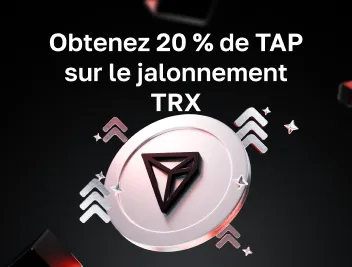
Le staking de crypto en vaut-il la peine : avantages et inconvénients
Le développement des cryptomonnaies offre de nombreuses façons de gagner de l'argent, dont l'une est le staking. Cela signifie recevoir des récompenses sous forme de crypto pour soutenir le réseau, ce qui est une manière assez facile d'augmenter vos actifs. Cependant, le staking comporte également certains risques dont vous devez être conscient avant de commencer à investir. Dans cet article, nous examinerons plus en profondeur la question du staking de cryptomonnaies et explorerons les avantages et les inconvénients de ce processus.
Qu'est-ce que le staking ?
Comme nous l'avons déjà mentionné, le staking est l'un des moyens populaires de générer des revenus à partir des cryptomonnaies. Son fonctionnement est le suivant : le propriétaire des actifs numériques envoie une partie de ceux-ci à la blockchain, garantissant ainsi la haute sécurité et la performance du réseau. Pour cette contribution, le participant reçoit des récompenses sous forme d'un pourcentage des rendements.
Le staking fonctionne sur l'algorithme PoS (Proof of Stake) et utilise des contrats intelligents. Le processus lui-même implique de verrouiller ses jetons pour le fonctionnement du réseau blockchain. De cette manière, lorsque de nouveaux participants mettent en staking leurs pièces, ils aident à sécuriser le réseau et à valider les transactions. Cependant, toutes les réseaux ne permettent pas le staking — cette liste est limitée. Parmi les blockchains les plus populaires pour le staking, on trouve Ethereum, Cardano, Solana, etc.
De nombreux investisseurs sont attirés par le staking en raison de son potentiel de revenu passif et de sa simplicité, car aucun équipement technique spécial n'est requis. Néanmoins, le staking présente ses avantages et ses risques, comme toutes les formes de revenus en cryptomonnaie.
Avantages du staking
Le staking présente de nombreux avantages. Tout d'abord, il est choisi pour sa capacité à générer des revenus passifs. En même temps, le staking est beaucoup plus large — examinons de plus près ses avantages.
Obtenir des revenus passifs
Comme mentionné ci-dessus, le staking de cryptomonnaies implique de verrouiller vos pièces dans le portefeuille du réseau. La taille de ces récompenses varie en fonction du réseau et de la quantité de cryptomonnaies mises en staking, mais dans tous les cas, elles généreront des revenus pour vous. De cette manière, vous recevrez toujours de l'argent sans avoir à trader activement si vous mettez en staking.
Taux d'intérêt élevés des récompenses
Le staking de cryptomonnaies offre des rendements plus élevés que les investissements traditionnels — le taux de récompense annuel moyen est de 11 %. Certains réseaux offrent 20 %, et d'autres offrent 50 %. Ces conditions de retour favorables rendent le staking très attrayant pour augmenter les actifs en cryptomonnaies.
Réseau sécurisé
Le staking fonctionne dans un cadre décentralisé, ce qui implique qu'il n'y a pas de "patron" unique. Ce fait réduit considérablement les risques de fonctionnement du réseau. En retour, les participants du réseau maintiennent l'intégrité du réseau et la sécurité de la blockchain en contribuant leurs pièces. Cette contribution à la stabilité du réseau est bénéfique financièrement et idéologiquement, car tous les participants sont intéressés par le succès du fonctionnement du réseau. De plus, cela encourage les validateurs qui traitent les transactions à agir dans le meilleur intérêt du réseau.
Gestion du réseau
La nature décentralisée du réseau permet à chaque membre d'influencer ses changements. Par exemple, les stakers ont leur mot à dire lors de la prise de décisions sur les mises à jour du protocole. Ainsi, ils participent à la formation de la direction future du réseau. Cette mesure garantit que chaque participant est à l'aise avec les conditions et le mode de fonctionnement.
Efficacité énergétique du réseau
Le staking ne nécessite aucune connaissance technique spéciale — il suffit de garder vos pièces ou jetons dans votre portefeuille pour faire du staking de cryptomonnaies. C'est un processus économe en énergie et respectueux de l'environnement qui nécessite une puissance de calcul minimale pour créer des blocs et vérifier les transactions.

Inconvénients du staking
Bien que le staking soit destiné à augmenter les profits, il comporte également certains risques. Ils sont liés aux changements du marché et à la sécurité. Examinons-les !
Risque de volatilité
Il existe un risque de perte en raison de la volatilité du marché. Si le prix de la cryptomonnaie mise en staking chute, vous risquez de ne pas obtenir de profit, ou de vous retrouver avec moins d'actifs que ceux investis initialement. Par conséquent, prenez en compte les risques possibles associés à la volatilité du marché et diversifiez votre portefeuille. Par exemple, investissez une partie de vos actifs dans le staking avec des variations de taux importantes et la possibilité de rendements élevés, et l'autre partie dans une cryptomonnaie avec un taux plus stable, mais une faible capitalisation.
Besoin d'un investissement minimum
La plupart des réseaux exigent une quantité minimale pour pouvoir faire du staking. Par exemple, pour le staking d'Ethereum, vous devez déposer 32 ETH pour commencer. Dans ce cas, vous avez la possibilité de devenir un validateur complet du réseau. Cependant, si vous ne possédez pas les pièces minimales requises, le staking peut constituer un obstacle. Dans ce cas, vous pouvez faire du staking en utilisant des pools et partager les récompenses avec d'autres participants.
Verrouillage des jetons
Le staking de cryptomonnaies suppose de verrouiller les jetons pendant une certaine période de temps. Par exemple, si vous mettez en staking vos pièces pendant un an, vous n'aurez pas accès à celles-ci pendant cette période. Dans ce cas, il existe un risque de manquer des opportunités d'investissement et de ne pas pouvoir réagir rapidement aux fluctuations des prix. Cependant, la période de verrouillage varie en fonction du réseau, vous devez donc choisir celui dont la période de verrouillage vous convient le mieux.
Risques techniques
Travailler dans un réseau de staking comporte toujours le risque de problèmes techniques et de fraude. En la matière, la sécurité des participants dépend entièrement de la plateforme qu'ils utilisent pour le staking : elle doit être réputée et sécurisée.
Si vous faites du staking sur Cryptomus, le risque sera réduit au minimum : la plateforme est protégée par une technologie de cryptage, et tous les participants du réseau, qu'ils soient validateurs ou délégataires, sont vérifiés avant l'inscription. Vous pouvez donc être sûr que vos fonds sont sécurisés. Si vous avez des questions ou des difficultés pour travailler avec la plateforme, le support technique vous aidera rapidement à rendre votre travail confortable.
Validateurs peu scrupuleux
Il y a des cas où les validateurs du réseau refusent de transférer les paiements aux investisseurs. Et dans certains projets de staking, les récompenses ne sont versées qu'après une longue période. En plus de choisir une plateforme fiable, vous devez apprendre en détail les règles du staking sur celle-ci. Découvrez le montant des récompenses, étudiez les règles de retrait et vérifiez les dates de paiement. Et ne jamais envoyer de fonds directement au validateur, car cela est un signe de fraude.
Le staking en vaut-il la peine ?
Le staking permet aux propriétaires de cryptomonnaies de gagner des revenus passifs à long terme. Les récompenses, quant à elles, sont générées à partir de taux d'intérêt relativement élevés, multipliant ainsi considérablement les fonds des participants. Ainsi, le staking est un moyen fiable et rentable de gagner des revenus passifs, qui aide également les investisseurs à réduire les risques liés aux fluctuations des prix à court terme.
En plus de la stabilité des revenus, le staking assure la sécurité du réseau grâce à l'investissement des stakers eux-mêmes. Bien sûr, il y a toujours un risque de fraude et de piratage, mais l'utilisation d'une plateforme fiable élimine cet obstacle, rendant le staking totalement sûr et rentable.
Avant de commencer à faire du staking, recherchez en détail votre cryptomonnaie, étudiez les avantages et les risques de la plateforme que vous allez utiliser et surveillez le marché. Ces mesures vous aideront à investir de manière rentable et sécurisée.
Nous espérons que ce guide vous a aidé à comprendre pleinement les avantages et les inconvénients du staking. Si vous avez encore des questions, vous pouvez les poser dans les commentaires.
Notez l'article








commentaires
0
Vous devez être connecté pour poster un commentaire